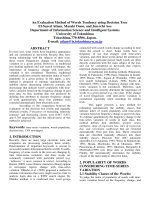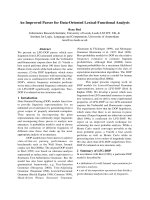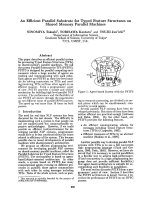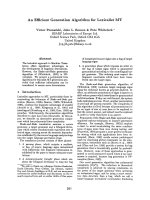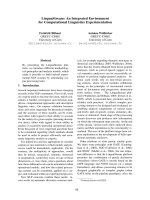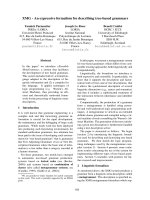Báo cáo khoa học: "An Efficient Method for Determining Bilingual Word Classes" doc
Bạn đang xem bản rút gọn của tài liệu. Xem và tải ngay bản đầy đủ của tài liệu tại đây (487.84 KB, 6 trang )
Proceedings of EACL '99
An Efficient Method for Determining Bilingual Word Classes
Franz
Josef Och
Lehrstuhl ffir Informatik VI
RWTH Aachen - University of Technology
Ahornstrai3e 55
52056 Aachen
GERMANY
Abstract
In statistical natural language process-
ing we always face the problem of sparse
data. One way to reduce this problem is
to group words into equivalence classes
which is a standard method in statistical
language modeling. In this paper we de-
scribe a method to determine bilingual
word classes suitable for statistical ma-
chine translation. We develop an opti-
mization criterion based on a maximum-
likelihood approach and describe a clus-
tering algorithm. We will show that the
usage of the bilingual word classes we get
can improve statistical machine transla-
tion.
1 Introduction
Word classes are often used in language modelling
to solve the problem of sparse data. Various clus-
tering techniques have been proposed (Brown et
al., 1992; Jardino and Adda, 1993; Martin et al.,
1998) which perform automatic word clustering
optimizing a maximum-likelihood criterion with
iterative clustering algorithms.
In the field of statistical machine translation
we also face the problem of sparse data. Our
aim is to use word classes in statistical machine
translation to allow for more robust statistical
translation models. A naive approach for doing
this would be the use of mono-lingually optimized
word classes in source and target language. Un-
fortunately we can not expect these independently
optimized classes to be correspondent. There-
fore mono-lingually optimized word classes do not
seem to be useful for machine translation (see also
(Fhng and Wu, 1995)). We define
bilingual word
clustering as
the process of forming correspond-
ing word classes suitable for machine translation
purposes for a pair of languages using a parallel
training corpus.
The described method to determine bilingual
word classes is an extension and improvement
of the method mentioned in (Och and Weber,
1998). Our approach is simpler and computation-
ally more efficient than (Wang et al., 1996).
2 Monolingual Word Clustering
The task of a statistical language model is to es-
timate the probability Pr(w N) of a sequence of
words
w N = wl wg.
A simple approximation
of Pr(w N) is to model it as a product of bigram
probabilities:
Pr(w~) N
= I-[i=1P(WilWi-1) •
If we
want to estimate the bigram probabilities
p(w[w')
using a realistic natural language corpus we are
faced with the problem that most of the bigrams
are rarely seen. One possibility to solve this prob-
lem is to partition the set of all words into equiv-
alence classes. The function C maps words w to
their classes C(w). Rewriting the corpus probabil-
ity using classes we arrive at the following proba-
bility model
p(wNlC):
N
P(wNIC) :=
i=1
(1)
In this model we have two types of probabili-
ties: the transition probability
p(CIC ~)
for class
C given its predecessor class C' and the member-
ship probability
p(wlC )
for word w given class C.
To determine the optimal classes C for a given
number of classes M we perform a maximum-
likelihood approach:
C = arg mpx p(w lc) (2)
We estimate the probabilities of Eq. (1) by
relative frequencies:
p(CIC' )
:=
n(CIC')/n(C'),
p(wlC ) = n(w)/n(C).
The function n(-) provides
the frequency of a uni- or bigram in the training
corpus. If we insert this into Eq. (2) and apply
the negative logarithm and change the summa-
tion order we arrive at the following optimization
71
Proceedings of EACL '99
criterion LP1 (Kneser and Ney, 1991):
LPx(C,n) = - ~
h(n(C]C'))
C,C'
+2 Zh(n(C)) (3)
C
= argm~n LPI(C,n). (4)
The function h(n) is a shortcut for n. log(n).
It is necessary to fix the number of classes in
C in advance as the optimum is reached if every
word is a class of its own. Because of this it is
necessary to perform an additional optimization
process which determines the number of classes.
The use of leaving-one-out in a modified optimiza-
tion criterion as in (Kneser and Ney, 1993) could
in principle solve this problem.
An efficient optimization algorithm for LP1 is
described in section 4.
3 Bilingual Word Clustering
In bilingual word clustering we are interested in
classes ~" and C which form partitions of the vo-
cabulary of two languages. To perform bilingual
word clustering we use a maximum-likelihood ap-
proach as in the monolingnal case. We maximize
the joint probability of a bilingual training corpus
(el, f J):
= argma (5)
$,fi
= argmax p(e/[C) .p(fJle~;C,3)(6)
$,~"
To perform the maximization of Eq. (6) we have to
model the monolingual a priori probability
p(e I IE)
and the translation probability
p(fJte~; E, .T).
For
the first we use the class-based bigram probability
from Eq. (1).
To model
p(fJle~;8,.T)
we assume the exis-
tence of an alignment a J. We assume that ev-
ery word fj is produced by the word e~j at posi-
tion aj in the training corpus with the probability
P(f~le,~i):
J
p(f lc ') = 1] p(L Icon)
j=l
(7)
The word alignment a J is trained automatically
using statistical translation models as described in
(Brown et al., 1993; Vogel et al., 1996). The idea
is to introduce the unknown alignment al J as hid-
den variable into a statistical model of the trans-
lation probability
p(fJle~).
By applying the EM-
algorithm we obtain the model parameters. The
alignment a J that we use is the Viterbi-Alignment
of an HMM alignment model similar to (Vogel et
al., 1996).
By rewriting the translation probability using
word classes, we obtain (corresponding to Eq. (1)):
J
p(f le '; E, = 1]
j=l
(s)
The variables F and E denote special classes in
9 v and ~'. We use relative frequencies to estimate
p(FIE) and p(flF):
p(F[E) = nt(FIE)/ (~F hi(FIE))
The function
nt(FIE)
counts how often the words
in class F are aligned to words in class E. If we
insert these relative frequencies into Eq. (8) and
apply the same transformations as in the monolin-
gual case we obtain a similar optimization crite-
rion for the translation probability part of Eq. (6).
Thus the full optimization criterion for bilingual
word classes is:
- ~
h(n(E[E'))
- ~
h(nt(FIE))
E,E' E,F
+2Eh(n(E))
E
+ Z h(~-~'
nt(FIE))+
~ ~ h(E
nt(FIE))
F E E F
The two count functions
n(EIE' )
and
nt(FIE )
can
be combined into one count function
ng(X[Y ) :=
n(XIY)+nt(X[Y ) as
for all words f and all words
e and e' holds
n(fle ) = 0
and
nt(ele' ) = O.
Using
the function ng we arrive at the following opti-
mization criterion:
LP2((C,~'),ng) = - ~
h(ng(ZlX')) +
X,X'
~h(ng,l(X)) +
Eh(ng,2(X))
(9)
X x
(~,~) = argmin LP2((E,~-),ng) (10)
Here we defined ng,l(X)
= ~'~x, ng(X[X')
and
ng,2(X)
= ~"~x' ng(X'[X).
The variable X runs
over the classes in E and Y. In the optimiza-
tion process it cannot be allowed that words of
72
Proceedings of EACL '99
INPUT: Parallel corpus (e~,/~) and number of classes in 6 and ~.
Determine the word alignment a~.
Get some initial classes C and ~.
UNTIL convergence criterion is met:
FOR EACH word e:
FOR EACH class E:
[Determine the change of LP((E, 9v), rig) if e is moved to E.
Move e to the class with the largest improvement.
FOR EACH 'word f:
FOR EACH class F:
~ the change of LP((C,.gv),
rig)
if
f is moved to F.
Move f to the class with the largest improvement.
OUTPUT: Classes C and 5 r.
Figure 1: Word Clustering Algorithm.
different languages occur in one class. It can be
seen that Eq. (3) is a special case of Eq. (9) with
•g,1 rig,2.
Another possibility to perform bilingual word
clustering is to apply a two-step approach. In a
first step we determine classes £ optimizing only
the monolingual part of Eq. (6) and secondly we
determine classes 5~ optimizing the bilingual part
(without changing C):
= argm~n LP2(~,n) (11)
.~ = argm~n LP2((E, Sr),n~). (12)
By using these two optimization processes we en-
force that the classes E are mono-lingually 'good'
classes and that the classes fi- correspond to ~.
Interestingly enough this results in a higher trans-
lation quality (see section 5).
4 Implementation
An efficient optimization algorithm for LPz is the
exchange algorithm (Martin et al., 1998). For
the optimization of LP2 we can use the same al-
gorithm with small modifications. Our starting
point is a random partition of the training corpus
vocabulary. This initial partition is improved it-
eratively by moving a single word from one class
to another. The algorithm to determine bilingual
classes is depicted in Figure 1.
If only one word w is moved between the parti-
tions C and C' the change
LP(C, ng) - LP(C', ng)
can be computed efficiently looking only at classes
C for which
ng(w,
C) > 0 or
ng(C,
w) > 0. We de-
fine M0 to be the average number of seen predeces-
sor and successor word classes. With the notation
I for the number of iterations needed for conver-
gence, B for the number of word bigrams, M for
the number of classes and V for the vocabulary
• • . , • • • . . . •
fifty-eight
•
six • •
frca
Hanover
" " ]" •
I•
frn~ "
hourlYtraingOesthe
• • • 'I 4"
m 13
Figure 2: Examples of alignment templates ~.
size the computational complexity of this algo-
rithm is roughly I. (B. log 2
(B/V) + V. M. Mo).
A detailed analysis of the complexity can be found
in (Martin et al., 1998).
The algorithm described above provides only a
local optimum. The quality of the resulting local
optima can be improved if we accept a short-term
degradation of the optimization criterion during
the optimization process. We do this in our imple-
mentation by applying the optimization method
threshold accepting
(Dueck and Scheuer, 1990)
which is an efficient simplification of
simulated an-
nealing.
73
Proceedings of EACL '99
Table 1: The EUTRANS-I corpus.
Train:
Test:
Sentences
Words
Vocabulary Size
Sentences
Words
Bigr. Perplexity
Spanish English
10000
97131 99292
686 513
2 996
35023 35590
-
5.2
Table 2: The EUTRANS-II corpus.
German English
Train: 16 226
Test:
Sentences
Words
Vocabulary Size
Sentences
Words
Bigr. Perplexity
266080 299945
39511 25751
187
2 556 2 853
-
157
5 Results
The statistical machine-translation method de-
scribed in (Och and Weber, 1998) makes use of
bilingual word classes. The key element of this
approach are the
alignment templates
(originally
referred to as translation rules)which are pairs of
phrases together with an alignment between the
words of the phrases. Examples of alignment tem-
plates are shown in Figure 2. The advantage of the
alignment template approach against word-based
statistical translation models is that word context
and local re-orderings are explicitly taken into ac-
count.
The alignment templates are automatically
trained using a parallel training corpus. The
translation of a sentence is done by a search pro-
cess which determines the set of alignment tem-
plates which optimally cover the source sentence.
The bilingual word classes are used to general-
ize the applicability of the alignment templates in
search. If there exists a class which contains all
cities in source and target language it is possible
that an alignment template containing a special
city can be generalized to all cities. More details
are given in (Och and Weber, 1998; Och and Ney,
1999).
We demonstrate results of our bilingual clus-
tering method for two different bilingual corpora
(see Tables 1 and 2). The EUTRANS-I corpus is
a subtask of the "Traveller Task" (Vidal, 1997)
which is an artificially generated Spanish-English
corpus. The domain of the corpus is a human-
to-human communication situation at a reception
Table 3: Example of bilingual word classes (corpus
EUTRANS-I, method BIL-2).
El: how it pardon what when where which.
who
why
E2: my our
E3: today tomorrow
E4: ask call make
E5: carrying changing giving looking
moving putting sending showing waking
E6: full half quarter
$1: c'omo cu'al cu'ando cu'anta
d'onde
dice dicho hace qu'e qui'en tiene
$2: ll'eveme mi mis nuestra nuestras
nuestro nuestros s'ub~nme
$3: hoy manana
mismo
$4: hacerme ll'ameme ll'amenos llama
llamar llamarme llamarnos llame p'idame
p'idanos pedir pedirme
pedirnos
pida pide
$5: cambiarme cambiarnos
despertarme
despertarnos
llevar llevarme llevarnos
subirme subirnos usted ustedes
$6: completa cuarto media menos
desk of a hotel. The EUTRANS-II corpus is a natu-
ral German-English corpus consisting of different
text types belonging to the domain of tourism:
bilingual Web pages of hotels, bilingual touristic
brochures and business correspondence. The tar-
get language of our experiments is English.
We compare the three described methods to
generate bilingual word classes. The classes
MONO are determined by monolingually opti-
mizing source and target language classes with
Eq. (4). The classes BIL are determined by bilin-
gually optimizing classes with Eq. (10). The
classes BIL-2 are determined by first optimiz-
ing mono-lingually classes for the target language
(English) and afterwards optimizing classes for
the source language (Eq. (11) and Eq. (12)).
For EUTRANS-I we used 60 classes and for
EUTRANS-II we used 500 classes. We chose the
number of classes in such a way that the final per-
formance of the translation system was optimal.
The CPU time for optimization of bilingual word
classes on an Alpha workstation was under 20 sec-
onds for EUTRANS-I and less than two hours for
EUTRANS-II.
Table 3 provides examples of bilingual word
classes for the EUTRANS-I corpus. It can be seen
that the resulting classes often contain words that
are similar in their syntactic and semantic func-
tions. The grouping of words with a different
74
Proceedings of EACL '99
Table 4: Perplexity (PP) of different classes.
Corpus MONO BIL BIL-2
EUTRANS-I 2.13 197: 198:
EUTRANS-II 13.2 . .
Table 5: Average e-mirror of different classes.
Corpus [MONO [BIL BIL-2
EUTRANS-I I 3.5 I 2.6
2.6
EUTRANS-II 2.2 1.8 2.0
meaning like today and tomorrow does not im-
ply that these words should be translated by the
same Spanish word, but it does imply that the
translations of these words are likely to be in the
same Spanish word class.
To measure the quality of our bilingual word
classes we applied two different evaluation mea-
sures:
1. Average e-mirror size (Wang et al., 1996):
The e-mirror of a class E is the set of classes
which have a translation probability greater
than e. We use e = 0.05.
2. The perplexity of the class transition proba-
bility on a bilingual test corpus:
exp
j-1. y~ maxi log
(p (g (fj) Ig (ei)))
j=l
Both measures determine the extent to which the
translation probability is spread out. A small
value means that the translation probability is
very focused and that the knowledge of the source
language class provides much information about
the target language class.
Table 4 shows the perplexity of the obtained
translation lexicon without word classes, with
monolingual and with bilingual word classes. As
expected the bilingually optimized classes (BIL,
BIL-2) achieve a significantly lower perplexity and
a lower average e-mirror than the mono-lingually
optimized classes (MONO).
The tables 6 and 7 show the translation qual-
ity of the statistical machine translation system
described in (Och and Weber, 1998) using no
classes (WORD) at all, mono-lingually, and bi-
lingually optimized word classes. The trans-
lation system was trained using the bilingual
training corpus without any further knowledge
sources. Our evaluation criterion is the word er-
ror rate (WER) the minimum number of in-
Table 6: Word error rate (WER) and average
alignment template length (AATL) on EUTRANS-
I.
Method
WORD
MONO
BIL
BIL-2
WER [70] I AAq'L
6.31 2.85
5.64 5.03
5.38 4.40
4.76 5.19
Table 7: Word error rate (WER) and average
alignment template length (AATL) on EUTRANS-
II.
Method
WORD
MONO
BIL
BIL-2
WER [%] I AATL
64.3 1.36
63.5 1.74
63.2 1.53
62.5 1.54
sertions/deletions/substitutions relative to a ref-
erence translation.
As expected the translation quality improves
using classes. For the small EuTRANS-I task the
word error rates reduce significantly. The word er-
ror rates for the EUTRANS-II task are much larger
because the task has a very large vocabulary and is
more complex. The bilingual classes show better
results than the monolingual classes MONO. One
explanation for the improvement in translation
quality is that the bilingually optimized classes
result in an increased average size of used align-
ment templates. For example the average length
of alignment templates with the EUTRANS-I cor-
pus using WORD is 2.85 and using BIL-2 it is
5.19. The longer the average alignment template
length, the more context is used in the translation
and therefore the translation quality is higher.
An explanation for the superiority of BIL-2
over BIL is that by first optimizing the English
classes mono-lingually, it is much more probable
that longer sequences of classes occur more often
thereby increasing the average alignment template
size.
6 Summary and future works
By applying a maximum-likelihood approach to
the joint probability of a parallel corpus we ob-
tained an optimization criterion for bilingual word
classes which is very similar to the one used in
monolingual maximum-likelihood word clustering.
For optimization we used the exchange algorithm.
The obtained word classes give a low translation
lexicon perplexity and improve the quality of sta-
75
Proceedings of EACL '99
tistical machine translation.
We expect improvements in translation quality
by allowing that words occur in more than one
class and by performing a hierarchical clustering.
Acknowledgements This work has been par-
tialIy supported by the European Community un-
der the ESPRIT project number 30268 (EuTrans).
References
P. F. Brown, V. J. Della Pietra, P. V. deSouza,
J. C. Lai, and R. L. Mercer. 1992. Class-based
n-gram models of natural language.
Computa-
tional Linguistics,
18(4):467-479.
Peter F. Brown, Stephen A. Della Pietra, Vin-
cent J. Della Pietra, and Robert L. Mercer.
1993. The mathematics of statistical machine
translation: Parameter estimation.
Computa-
tional Linguistics,
19 (2) :263-311.
G. Dueck and T. Scheuer. 1990. Threshold ac-
cepting: A general purpose optimization al-
gorithm appearing superior to simulated an-
nealing.
Journal of Computational Physics,
90(1):161-175.
Pascale Fung and Dekai Wu. 1995. Coerced
markov models for cross-lingual lexical-tag re-
lations. In The
Sixth International Conference
on Theoretical and Methodological Issues in Ma-
chine Translation,
pages 240-255, Leuven, Bel-
gium, July.
M. Jardino and G. Adda. 1993. Automatic Word
Classification Using Simulated Annealing. In
Proc. Int. Conf. on Acoustics, Speech, and Sig-
nal Processing,
volume 2, pages 41-44, Min-
neapolis.
R. Kneser and H. Ney. 1991. Forming Word
Classes by Statistical Clustering for Statistical
Language Modelling. In
1. Quantitative Lin-
guistics Conference.
R. Kneser and H. Ney. 1993. Improved Cluster-
ing Techniques for Class-Based Statistical Lan-
guage Modelling. In
European Conference on
Speech Communication and Technology,
pages
973-976.
Sven Martin, JSrg Liermann, and Hermann Ney.
1998. Algorithms for bigram and trigram word
clustering.
Speech Communication,
24(1):19-
37.
Franz Josef Och and Hermann Ney. 1999. The
alignment template approach to statistical ma-
chine translation. To appear.
Franz Josef Och and Hans Weber. 1998. Im-
proving statistical natural language translation
with categories and rules. In
Proceedings of the
35th Annual Conference of the Association for
Computational Linguistics and the 17th Inter-
national Conference on Computational Linguis-
tics,
pages 985-989, Montreal, Canada, August.
Enrique Vidal. 1997. Finite-state speech-to-
speech translation. In
Proc. Int. Conf. on
Acoustics, Speech, and Signal Processing,
vol-
ume 1, pages 111-114.
Stephan Vogel, Hermann Ney, and Christoph Till-
mann. 1996. HMM-based word alignment in
statistical translation. In
COLING '96: The
16th Int. Conf. on Computational Linguistics,
pages 836-841, Copenhagen, August.
Ye-Yi Wang, John Laiferty, and Alex Waibel.
1996. Word clustering with parallel spoken lan-
guage corpora. In
Proceedings of the ~th Inter-
national Conference on Spoken Language Pro-
cesing (ICSLP'96),
pages 2364-2367.
76




